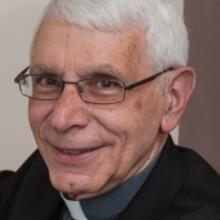A Striking Original
I am always intrigued by the epigraph an author uses to set the thematic mood for his or her work. Gerald O’Collins is prodigal with epigraphs, often providing one or two to introduce each chapter. Perhaps most telling is the one with which he prefaces the last chapter of his latest book, Jesus: A Portrait. It comes from an address by Pope Benedict XVI and reads: “If we let Christ into our lives we lose nothing, nothing, absolutely nothing of what makes life free, beautiful, and great.” The professor emeritus of systematic theology at Rome’s Gregorian University has, in effect, responded in a most personal way to the further question the epigraph poses: who is this Christ whose following makes our lives “free, beautiful, and great?”
O’Collins frames his portrait in a fascinating way. His opening chapter, “The Beauty of Jesus,” is a lovely meditation inspired by St. Augustine’s praises of the beauty of Christ: “beautiful in heaven, beautiful on earth, beautiful when inviting to life, beautiful when laying life down.” This aesthetic sensitivity permeates the book, as O’Collins invokes painters like Michelangelo and Caravaggio, and musicians like Bach and Mozart. And the last chapter, “Jesus the Abiding Presence,” offers an extended reflection upon 10 encounters with Jesus in the Fourth Gospel, prototypical of disciples’ ongoing relationship with the Lord.
This way of framing his portrait indicates a further salient feature of O’Collins’s approach. An exploration into the mystery of Jesus is no disinterested investigation; it engages the whole being of the one embarking on the quest. From the first words of Jesus in the Fourth Gospel—“what do you seek?”—to the pivotal question put at the midpoint of the Synoptics—“who do you say I am?”—the identity of Jesus and the identity of the seeker are inextricably related. The portrait of the Lord invariably bears traces of the self-portrait of the disciple.
The canonical Gospels serve as inspiration and criterion for O’Collins’s own re-presentation. His longstanding commitment to a hermeneutics of trust in the Gospel accounts has only been reinforced by the careful study of Richard Bauckham, Jesus and the Eyewitnesses, upon which he liberally draws. Further, in eminently Catholic fashion, O’Collins reads Scripture within (and not separate from) the church’s tradition. He early on makes clear his Chalcedonian optic and commitment, devoting Chapter 3 to “Jesus Divine and Human.”
The compelling attraction of the book, however, is O’Collins’s personal meditation and appropriation of the Gospel tradition. His palette brings out the distinctive colors of a portrait that has faded for some because of a presumed over-familiarity. What progressively emerges is the striking originality of Jesus, whose beatifying vision saw all creation charged with the presence of the Father and whose stupendous imagining evoked a humanity transformed. Jesus proclaimed the extraordinary magnanimity of God, often in sad contrast to human mean-spiritedness: God’s generosity in counterpoint to human begrudging.
Thus the chapter on “Jesus the Story-Teller” rehearses well-known parables, displaying them in a suggestive configuration of invitation and reception, ardent living and confident expectation. O’Collins’s treatment enkindles a new appreciation of the integrity and urgency of Jesus’ summons to lay hold of the pearl of great price, as well as a new realization of the cost of such commitment. Little by little the pearl is revealed to be the parable-weaver, Jesus himself.
With Jesus, of course, the cost was no less than everything. Unlike some portraits that tend to marginalize the death of Jesus, minimizing its salvific import, O’Collins devotes two chapters to “Facing Death” and to “Jesus the Suffering Servant.” In an important methodological move, he sets the events of Jesus’ last days within the context of his characteristic attitudes and actions, the dispositions and decisions that guide his entire ministry. The life and death of Jesus illuminate and interpret each other. The gift of Jesus’ life is perfected in the gift of his eucharistic death. As O’Collins writes: “his words and gestures at the Last Supper incorporated his suffering and death into the great project of universal salvation, God’s coming kingdom.”
It is only fair to ponder how Gerald O’Collins’s portrait compares to Pope Benedict’s in his Jesus of Nazareth. There are, certainly, surface differences. The pope understandably draws for the most part upon German exegetes and discussions, while English-language scholars are O’Collins’s primary dialogue partners. The second part of the pope’s portrait still awaits completion, while O’Collins fills out his own with a careful consideration of the Lord’s death and resurrection to new life.
Perhaps more substantively, Pope Benedict’s writing style strikes me as more allusive and associative (in a word, more “patristic”). His reflections on Jesus’ conflict with the power of Satan, for example, the enemy of humankind, bathe his canvass in dramatic darkness, while O’Collins colors his portrait in softer hues—da Vinci to Ratzinger’s Tintoretto. In addition, the pope is more direct in relating the following of Jesus to present-day challenges.
But there is really scarce need to choose between them. As the ending of the Fourth Gospel insists: “Many other things Jesus did that are not written here. Indeed, if every one of them were written down, I doubt the world itself could contain all the books that would be written.” Father O’Collins’s carefully crafted book provides an alluring portrait of Jesus, whose beauty remains ever ancient and ever new. He most certainly concurs with the pope’s conviction, expressed in Benedict’s first encyclical, Deus Caritas Est: “The beginning of Christian existence is not an ethical decision or a sublime idea, but rather the encounter…with a person who gives life a new goal and, at the same time, a sure growth.”
This article also appeared in print, under the headline “A Striking Original,” in the September 8, 2008, issue.








